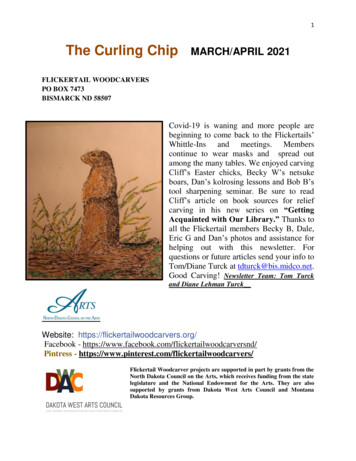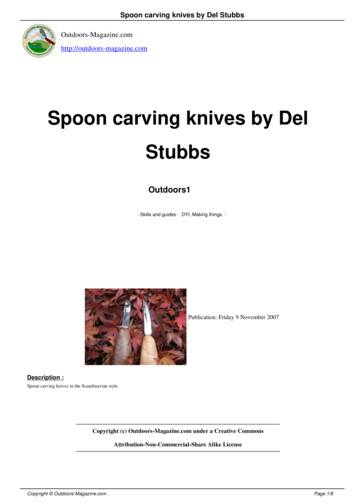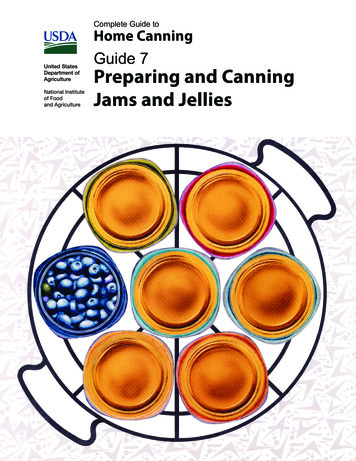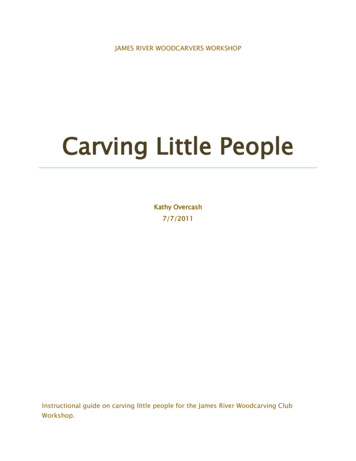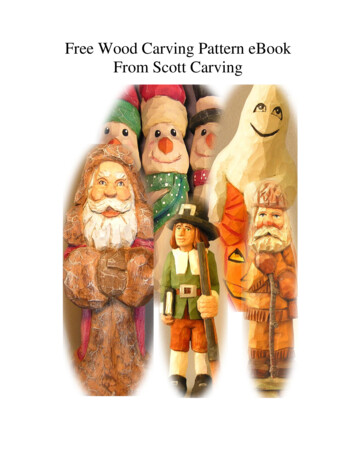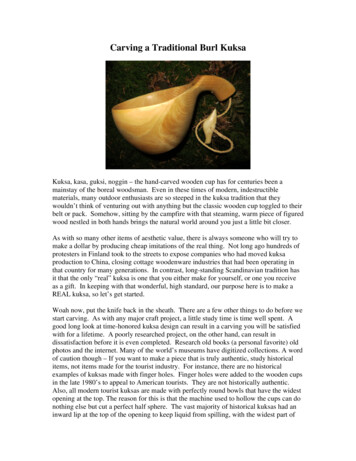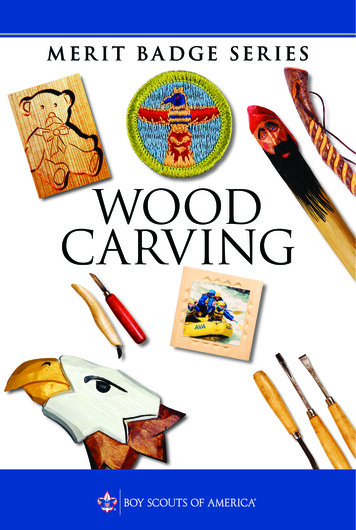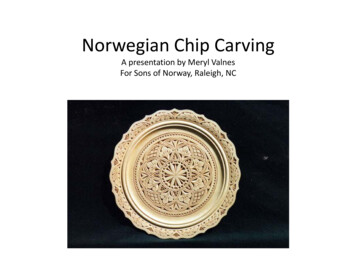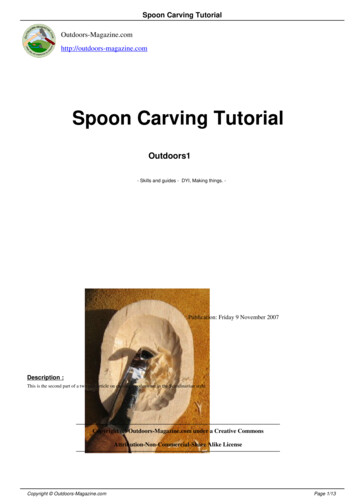
Transcription
Spoon Carving ine.comSpoon Carving TutorialOutdoors1- Skills and guides - DYI, Making things. -Publication: Friday 9 November 2007Description :This is the second part of a two part article on carving woodenware in the Scandinavian style.Copyright (c) Outdoors-Magazine.com under a Creative CommonsAttribution-Non-Commercial-Share Alike LicenseCopyright Outdoors-Magazine.comPage 1/13
Spoon Carving TutorialThis is the second part of a two part article on carving woodenware in the Scandinavian style.Part 1 (Here) discussed the woodworking tools and techniques for making bowls and troughs.This article will focus on carving spoons. Similar methods can be used for ladles. I'll post a reviewof the tools I used in another article.I have not shown the grips and holds that are required for this type of whittling. If you would like to see these shown,plese look up the references listed at the end or visit Del Stubbs.Del's website lots of great information on Scandinavian spoon carving techniques, carving grips, as well asinformation on how to select a natural crook for spoon carving, and even one on making your own birchbark knifesheath. Del is planning on adding some links to videos showing various carving techniques as well.Spoon Carving TutorialThe two blanks shown in the bowl are from Del Stubbs. One is basswood, the other is birch. Both of these woodsare easy to carve and have very fine grain. You can also make your own blanks from green wood. Please look atthe website linked above or the references at the end of this article for more information.Spoon blanks One blank is basswood, the other is birch.The spoon blanks have been cut into a traditional Scandinavian shape with a bandsaw and are ready to carve.Copyright Outdoors-Magazine.comPage 2/13
Spoon Carving TutorialSpoon blank side view The deep neck provides makes the spoon less likely to break.I like to start by refining the profile of the spoon. In the next photo I have smoothed out the handle shape and begunto carve away the excess wood on the bottom of the handle.Step 1. Smooth the top of the blank.Copyright Outdoors-Magazine.comPage 3/13
Spoon Carving TutorialStep 2. Remove the excess wood from the bottom of the handle.Step 3. This is a good time to change the shape or length of the handle. I opted for a simple curve for this example.Then I rough out the bottom of the bowlCopyright Outdoors-Magazine.comPage 4/13
Spoon Carving TutorialStep 4. Remove the corners from the bottom of the bowl. Keep removing the edges of the cuts til the surface issmooth.Step 4a. Be careful when working against the grain - it is easy to chip out more wood than you intend.Step 4b. Some careful trimming and the chip is repaired.Copyright Outdoors-Magazine.comPage 5/13
Spoon Carving TutorialStep 4c. Here is the bottom of the bowl, roughed out.Then I carve the hollow of the bowl. You can use just the spoon knife for this work, but I prefer to use a gouge torough out the bowl and save the fine edge of the spoon knife for the finishing work. Below are several tools that workfor the rough work.Other roughing tools You can hollow the bowl with just the spoon knife, but I prefer to start with a gouge of sometype and save the edge of the spoon knife for the finishing work.Copyright Outdoors-Magazine.comPage 6/13
Spoon Carving TutorialStep 5a. Hollowing with the large spoon gouge. If you hold the gouge as shown and keep the bottom of yourhand against the outside of the bowl, the gouge cannot easily slip and cut you. Note that you would cup the bowl ofthe spook in the opposite hand while carving.Step 5b. A smaller straight gouge. This small Japanese gouge is one of my favorites for the initial hollowing workon spoons.Copyright Outdoors-Magazine.comPage 7/13
Spoon Carving TutorialStep 5c. Initial hollowing is complete Now this is ready for the spoon knife.Step 6a. Smoothing the bowl. Spoon knife at work smoothing the bowl.Step 6b. Turn the spoon . to smooth the other side.Copyright Outdoors-Magazine.comPage 8/13
Spoon Carving TutorialStep 6c. Bowl is now smoothed.The spoon knife is handy on any inside curve . like the bottom of the handle.or the side of the handleCopyright Outdoors-Magazine.comPage 9/13
Spoon Carving TutorialHere's the rough carved blank, ready for fine tuning to get the bowl a bit deeper and to smooth out the lines.Carving mostly done .Here's the profileAt this point, I do a bit more hollowing with the spoon knife, and some smoothing on the exterior. As you work, besure to check the thickness of the bowl frequently. You do not want to make it too thin!Now the spoon is ready to sand and finish. I like to use food grade walnut oil, but any food safe finish will work. Mostgood woodworking stores will have one available. If you decide to use a raw food grade oil finish like walnut oil orflax seed oil, be aware that these finished can take a long time to cure. This doesn't really create a problem sincethese oils are edible.Copyright Outdoors-Magazine.comPage 10/13
Spoon Carving TutorialThe finished spoon This spoon has been sanded, scraped, and finished with walnut oil. It's ready to use!Two finished spoons and a bowlHere is a fine example carved by Schwert. Nice job!Copyright Outdoors-Magazine.comPage 11/13
Spoon Carving TutorialBuckthorn Eating Spoon Made from a blank supplied by Spoons of Wood. Del Stubbs spoon knives and ForgedOSF used by SchwertReferencesIf you found this article interesting, I encourage you to look up the three references I studied before writing the article.All three are currently out of print, but it is well worth the effort to find a copy at the library or via a used book seller."Swedish Carving Techniques" by Wille Sundqvist (Taunton Press, 1990, ISBN 0-942391-45-4). The original title is"Talja med kniv och yxa". This book provides an entire introductory course in making wooodenware in the Swedishstyle. The first sections of the book provide background information on selecting and sharpening tools, followed bysections on whittling techniques and spoon design and construction. The descriptions walk you through the entireprocess of making a spoon from selecting the blank, through whittling techniques, to finishing and detailing the finalproduct. The section on spoon design hilights the most common mistakes and ways to avoid them. One outstandingaspect of the text is the quality of the writing - Sundqvist explains why to do something, rather than just showing howhe does it. A truely excellent book.The companion video to Wille Sundqvist's book is "Carving Swedish Woodenware" (Jogge Sundqvist, TauntonPress, 1990, ISBN 0-942391-34-9). This video is another excellent reference. It summarizes the material from Wille'sCopyright Outdoors-Magazine.comPage 12/13
Spoon Carving Tutorialbook and shows all of the techniques in use. The dialog provides clear explanations of each step as Jogge steps theviewer through carving of a bowl and two spoons. An excellent reference in its own right, I highly recommend thisvideo for the beginning spoon or bowl carver.My final reference was "Carving & Whittling: The Swedish Style" by Gert Ljungberg and Inger A:son-Ljungberg (Larkbooks, 1998, ISBN 1-887374-40-x). This book starts with a good discussion of wood (specific to Sweden, though)and moves on to projects. The text provides an excellent overview (using photographs and sketches) of designs forbowls, spoons, and other greenwood projects. I think my favorite thing about this book is the way the authors presentseveral alternative methods to create similar items. I think this is a perfect book to stir the creative impulses for thosewho have already mastered the technical aspects described in Sundqvist. Also highly recommended.Copyright Outdoors-Magazine.comPage 13/13
My final reference was "Carving & Whittling: The Swedish Style" by Gert Ljungberg and Inger A:son-Ljungberg (Lark books, 1998, ISBN 1-887374-40-x). This book starts with a good discussion of wood (specific to Sweden, though) and moves on to projects. The text provides an excellent
